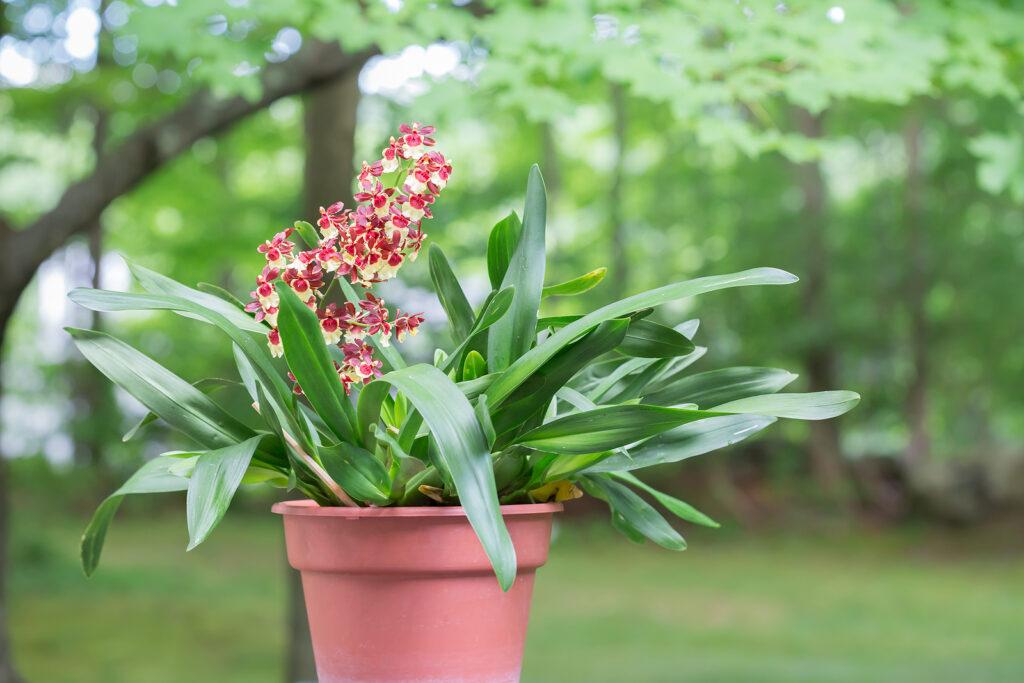Oncidium is a free-flowering orchid. Most produce long spikes of yellow flowers spotted or striped with brown; a few have white or rose-colored blooms. Blossoms may be small and numerous or large and sparse.
Oncidium is recommended for beginners because it is easy to grow and tolerates a wide range of growing conditions. It can be grown indoors in a bright windowsill or greenhouse. In subtropical or warmer climates, it can be grown outdoors in pots or on slabs of bark attached to tree trunks.
Oncidium is a genus of more than 450 species native to tropical and subtropical Mexico, Central and South America, and the West Indies. Some grow in trees others grow on mossy rocks.
Get to know Oncidium
- Plant type: Epiphytic orchid
- Growing zones and range: Zones 13-15
- Optimal growing temperature: day, 65° to 75°F (18° to 24°C); night, 55° to 60°F (13° to 16°C).
- Height and width: 12 to 24 inches (30-60cm) tall and 6 to 24 inches (15-60cm) wide depending on the variety.
- Foliage: Obland strap-shapled dark green leaves can be rigid or flexible
- Flowers: 3 lobed and often fiddle-shaped, bearing a characteristic warty crest and prominent lips; typically yellow; flowers can be small and numerious or large and sparse.
- Bloom time: Off and on during the year
- Uses: Houseplant, tropical garden
- Common name: Butterfly orchid, dancing lady orchid.
- Botanical name: Oncidium
- Family name: Orchidaceae
- Origin: Tropical and subtropical Mexico, Central and South America, West Indies

Where to plant Oncidium
- Light: Indoors Oncidium needs bright light from southern exposure; shade from direct summer sun at midday. Plants with thin leaves need more diffused light. Does well under artificial light, needing 12 to 16 light-hours daily. Good circulation of fresh air.
- Soil: Plant Oncidium in Osmunda fiber or orchid bark mix. 0. sphacelatum does well in slatted baskets.
When to plant Oncidium
- Set Oncidium outdoors in a tropical or subtropical garden any time during the year.
Planting and spacing Oncidium
- Space Oncidium 6 to 24 inches (15-60cm) apart depending on the variety.
How to water and feed Oncidium
- Water: Water freely and mist daily during the growin season. Let growing medium dry slightly between thorough waterings. Humidity, 50% to 70%.
- Feeding: Plants growing in Osmunda fiber need no fertilizing. Plants growing in orchid bark mix need monthly feeding during active growth with all-purpose fertilizer.
Oncidium care
- Keep Oncidiums with large pseudobulbs dry in winter; those with small pseudobulbs, or none, require watering all year.
- Oncidium rests after new pseudobulb and leaves mature, prior to flowering. Reduce water, giving only enough to keep pseudobulb from shriveling. O. flexuosum requires little or no rest period; do not reduce watering at any point in growth cycle.
Growing Oncidium as a houseplant
- Oncidium species with thin leaves should be gown in bright light; species with succulent leave prefer direct light.
- Humidity must be high; the temperature should be average.
- Grow in a soilless medium that contains fir or redwood bark or osmunda fiber.
- Dwarf varieties can be grown on slabs of tree fern.
- While the plant is growing and flowering, keep the medium evenly moist and fertilize twice monthly. When the plant is not flowering, allow the medium to dry slightly between waterings and do not fertilize.
- Tall varieties may need support.
Oncidium pests and diseases
- Check Oncidium for bacterial, fungal, or viral infection, mealybugs, scale, slugs, snails, whiteflies.
Oncidium propagation
- Divide Oncidium when the plants overflow theri containers or remove pseudobulbs and pot the up, with 3 to 4 pseudobulbs in each new pot.
Oncidium varieties to grow
- 0ncidium flexuosum. Grows to 24 inches (60cm) tall; bears many small yellow flowers flecked with brownish red at the base; lip is golden yellow with brown flecks at the base; blooms from spring through summer.
- 0. ornithorhynchum. Grows to 6 inches (15cm) tall; bears many small, fragrant, rosy lilac flowers on a pendulous stem; blooms appear in fall.
- O. sphacelatum. Grows to 24 inches (60cm) tall; bears yellow blooms with slightly ruffled edges, flecked with reddish brown; yellow lip has brown flecks; flowers in spring.
- 0. varicosum ‘Rogersii’, dancing Iady. Grows to 8 inches (20 cm) tall; bears 100 to 250 bright yellow flowers on a 3- to 5-foot (0.9 to 15 m) spray; wide, round lip is golden yellow with cleft in front; blooms in fall.



